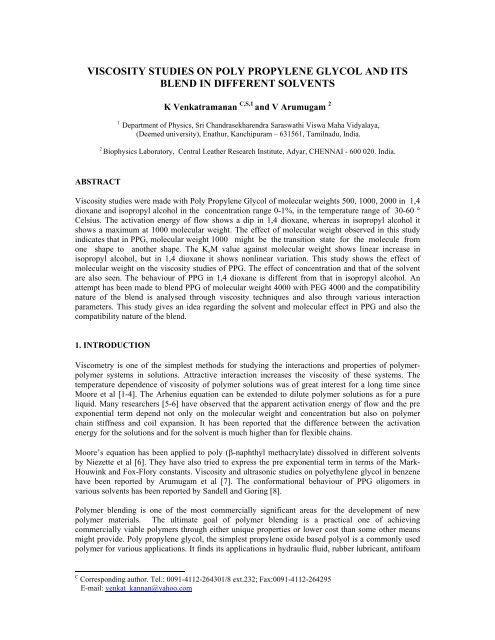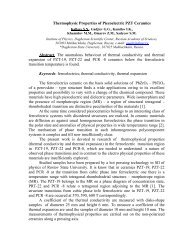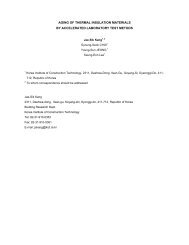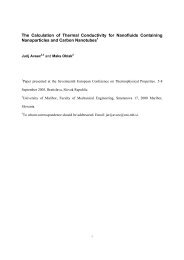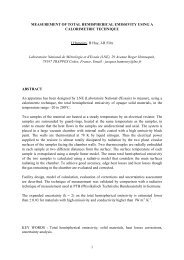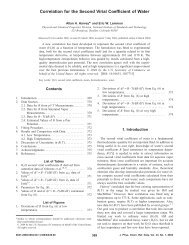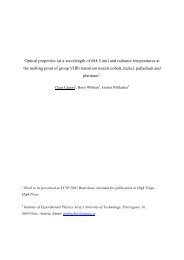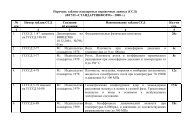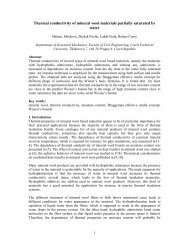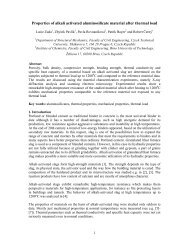Viscosity studies on poly propylene glycol (PPG ... - thermophysics.ru
Viscosity studies on poly propylene glycol (PPG ... - thermophysics.ru
Viscosity studies on poly propylene glycol (PPG ... - thermophysics.ru
You also want an ePaper? Increase the reach of your titles
YUMPU automatically turns print PDFs into web optimized ePapers that Google loves.
VISCOSITY STUDIES ON POLY PROPYLENE GLYCOL AND ITSBLEND IN DIFFERENT SOLVENTSK Venkatramanan C,S,1 and V A<strong>ru</strong>mugam 21Department of Physics, Sri Chandrasekharendra Saraswathi Viswa Maha Vidyalaya,(Deemed university), Enathur, Kanchipuram – 631561, Tamilnadu, India.2Biophysics Laboratory, Central Leather Research Institute, Adyar, CHENNAI - 600 020. India.ABSTRACT<str<strong>on</strong>g>Viscosity</str<strong>on</strong>g> <str<strong>on</strong>g>studies</str<strong>on</strong>g> were made with Poly Propylene Glycol of molecular weights 500, 1000, 2000 in 1,4dioxane and isopropyl alcohol in the c<strong>on</strong>centrati<strong>on</strong> range 0-1%, in the temperature range of 30-60 °Celsius. The activati<strong>on</strong> energy of flow shows a dip in 1,4 dioxane, whereas in isopropyl alcohol itshows a maximum at 1000 molecular weight. The effect of molecular weight observed in this studyindicates that in <strong>PPG</strong>, molecular weight 1000 might be the transiti<strong>on</strong> state for the molecule from<strong>on</strong>e shape to another shape. The K e M value against molecular weight shows linear increase inisopropyl alcohol, but in 1,4 dioxane it shows n<strong>on</strong>linear variati<strong>on</strong>. This study shows the effect ofmolecular weight <strong>on</strong> the viscosity <str<strong>on</strong>g>studies</str<strong>on</strong>g> of <strong>PPG</strong>. The effect of c<strong>on</strong>centrati<strong>on</strong> and that of the solventare also seen. The behaviour of <strong>PPG</strong> in 1,4 dioxane is different from that in isopropyl alcohol. Anattempt has been made to blend <strong>PPG</strong> of molecular weight 4000 with PEG 4000 and the compatibilitynature of the blend is analysed through viscosity techniques and also through various interacti<strong>on</strong>parameters. This study gives an idea regarding the solvent and molecular effect in <strong>PPG</strong> and also thecompatibility nature of the blend.1. INTRODUCTIONViscometry is <strong>on</strong>e of the simplest methods for studying the interacti<strong>on</strong>s and properties of <strong>poly</strong>mer<strong>poly</strong>mersystems in soluti<strong>on</strong>s. Attractive interacti<strong>on</strong> increases the viscosity of these systems. Thetemperature dependence of viscosity of <strong>poly</strong>mer soluti<strong>on</strong>s was of great interest for a l<strong>on</strong>g time sinceMoore et al [1-4]. The Arhenius equati<strong>on</strong> can be extended to dilute <strong>poly</strong>mer soluti<strong>on</strong>s as for a pureliquid. Many researchers [5-6] have observed that the apparent activati<strong>on</strong> energy of flow and the preexp<strong>on</strong>ential term depend not <strong>on</strong>ly <strong>on</strong> the molecular weight and c<strong>on</strong>centrati<strong>on</strong> but also <strong>on</strong> <strong>poly</strong>merchain stiffness and coil expansi<strong>on</strong>. It has been reported that the difference between the activati<strong>on</strong>energy for the soluti<strong>on</strong>s and for the solvent is much higher than for flexible chains.Moore’s equati<strong>on</strong> has been applied to <strong>poly</strong> (β-naphthyl methacrylate) dissolved in different solventsby Niezette et al [6]. They have also tried to express the pre exp<strong>on</strong>ential term in terms of the Mark-Houwink and Fox-Flory c<strong>on</strong>stants. <str<strong>on</strong>g>Viscosity</str<strong>on</strong>g> and ultras<strong>on</strong>ic <str<strong>on</strong>g>studies</str<strong>on</strong>g> <strong>on</strong> <strong>poly</strong>ethylene <strong>glycol</strong> in benzenehave been reported by A<strong>ru</strong>mugam et al [7]. The c<strong>on</strong>formati<strong>on</strong>al behaviour of <strong>PPG</strong> oligomers invarious solvents has been reported by Sandell and Goring [8].Polymer blending is <strong>on</strong>e of the most commercially significant areas for the development of new<strong>poly</strong>mer materials. The ultimate goal of <strong>poly</strong>mer blending is a practical <strong>on</strong>e of achievingcommercially viable <strong>poly</strong>mers through either unique properties or lower cost than some other meansmight provide. Poly <strong>propylene</strong> <strong>glycol</strong>, the simplest <strong>propylene</strong> oxide based <strong>poly</strong>ol is a comm<strong>on</strong>ly used<strong>poly</strong>mer for various applicati<strong>on</strong>s. It finds its applicati<strong>on</strong>s in hydraulic fluid, <strong>ru</strong>bber lubricant, antifoamC Corresp<strong>on</strong>ding author. Tel.: 0091-4112-264301/8 ext.232; Fax:0091-4112-264295E-mail: venkat_kannan@yahoo.com
agents and so <strong>on</strong>. The advantage of using viscosity measurements for investigating <strong>poly</strong>mer miscibilityhas been shown by many researchers [9-14].In the present study, an attempt has been made to test Moore's equati<strong>on</strong> for <strong>PPG</strong> of different molecularweight in different solvents and also to study the compatibility of <strong>PPG</strong> 4000 with PEG 4000 usingviscosity technique.2. MATERIALS AND METHODSPoly<strong>propylene</strong> <strong>glycol</strong> (<strong>PPG</strong>) of molecular weight 500, 1000 and 2000 were obtained as gift fromManali Petro products, Chennai. Polymer soluti<strong>on</strong>s were prepared by dissolving these <strong>poly</strong>mers in isopropyl alcohol and 1,4 dioxane to give c<strong>on</strong>centrati<strong>on</strong>s 0.1, 0.25, 0.5, 0.75, and 1%. The viscosity<str<strong>on</strong>g>studies</str<strong>on</strong>g> were carried out in an Ubbelhode viscometer and the timings were measured accurately (0.01s). The viscometer was kept in temperature c<strong>on</strong>trolled water bath ( + 0.5° C) during the experiment.The density of the soluti<strong>on</strong>s was measured using gravimetric method.2.1 BLEND PREPARATIONIn the present study, <strong>PPG</strong> 4000 is blended with PEG 4000 in the solvents Isopropyl Alcohol and 1,4Diax<strong>on</strong>e at 1% c<strong>on</strong>centrati<strong>on</strong>. The compositi<strong>on</strong>s of the blend <strong>PPG</strong> 4000: PEG 4000 were in thefollowing ratios 0:1, 0.2:0.8, 0.4:0.6, 0.5:0.5, 0.6:0.4, 0.8:0.2 and 1:0.3. RESULTS AND DISCUSSIONArhenius expressi<strong>on</strong> is valid for pure solvents and also for dilute <strong>poly</strong>mer soluti<strong>on</strong>s.According to Moore et al [4]η = A e Q/RT -------- (1)where Q is the apparent activati<strong>on</strong> energy of flow and A pre- exp<strong>on</strong>ential term with an activati<strong>on</strong>entropy significance. The logarithm of this equati<strong>on</strong> leads to a straight-line type.ln η = ln A + (Q/R ) 1/T --------(2)Fig.1 shows the variati<strong>on</strong>s of log viscosity against inverse of temperature for <strong>PPG</strong> 500 in thetemperature range of 30-60 ° C for Isopropyl alcohol and 1,4 Diax<strong>on</strong>e. The plots of <strong>PPG</strong> 1000 and2000 are also similar to these plots for both the solvents. Generally a drastic change in the (ln η)viscosity indicates c<strong>on</strong>formati<strong>on</strong>al transiti<strong>on</strong> of the <strong>poly</strong>mer chain. The straight line indicates that theviscosity did not change in this temperature range (303-333k)[6]. In all the cases the ln η valuesincrease with increase in the c<strong>on</strong>centrati<strong>on</strong> and temperature.0.100.050.00-0.05-0.10-0.15-0.20-0.25-0.30-0.35-0.40-0.45-0.503.00 3.05 3.10 3.15 3.20 3.25 3.300.0-0.2-0.4-0.6-0.8-1.03.00 3.05 3.10 3.15 3.20 3.25 3.30Fig1: Graph Between Log η And 1/ Temp for <strong>PPG</strong> 500 for (a)IPA and (b) 1,4 Diax<strong>on</strong>e
The slope of these curves gives the activati<strong>on</strong> energy. The variati<strong>on</strong> of Q with c<strong>on</strong>centrati<strong>on</strong> C is givenin Fig. 2.2220181614121080.0 0.2 0.4 0.6 0.8 1.022201816141210860.0 0.2 0.4 0.6 0.8 1.0Fig 2 : Graph between Q and CIt can be seen from the Fig.2 that the variati<strong>on</strong>s fit into a straight line and the corresp<strong>on</strong>ding slope andintercept values are found out. The activati<strong>on</strong> energy of flow, follows the equati<strong>on</strong>Q = Q 0 + K e M c ----------- (3)In this equati<strong>on</strong> K e is a c<strong>on</strong>stant, M is the molecular weight and C the c<strong>on</strong>centrati<strong>on</strong>. Q o is c<strong>on</strong>stantdependent <strong>on</strong> the <strong>poly</strong>mer and its molecular weight. The effect of c<strong>on</strong>centrati<strong>on</strong> was observed duringplotting Q against c<strong>on</strong>centrati<strong>on</strong> Fig.2 .The variati<strong>on</strong>s in the intercepts of ln η Vs 1/T plots, which are the A values, i.e. the pre exp<strong>on</strong>entialterm. The equati<strong>on</strong> that fit the values is given byA= A 0 e (K β M β c ) ----------(4)However, the variati<strong>on</strong>s of for <strong>PPG</strong> does not seem to follow the above equati<strong>on</strong> as <strong>poly</strong> (β - naphthylmethacrylate).-3.0-3.5-4.0-4.5-5.0-5.5-6.0-6.5-7.0-7.5-8.0-8.5-9.00.0 0.2 0.4 0.6 0.8 1.0-3.5-4.0-4.5-5.0-5.5-6.0-6.5-7.0-7.5-8.0-8.50.0 0.2 0.4 0.6 0.8 1.0Fig 3: Graph between intercept log A and c<strong>on</strong>centrati<strong>on</strong> C
The variati<strong>on</strong> of A with c<strong>on</strong>centrati<strong>on</strong> and molecular weight is given in Fig. 3. The ln A againstc<strong>on</strong>centrati<strong>on</strong> curves show that the general trend is a straight line and of the formA = A 0 + K γ M γ c ---------(5)In c<strong>on</strong>trast to ploy (β-naphthyl methacrylate) [6] <strong>PPG</strong> shows decreasing trend with increase inc<strong>on</strong>centrati<strong>on</strong> and molecular weight as can be seen from Fig.3.If the graph is drawn between activati<strong>on</strong> energy Q and c<strong>on</strong>centrati<strong>on</strong> C , according to eqn (2), wecan get the value of Q o from the intercept and the slope will give the value of KeM. The generaltrend seems to be the same, though the values are different in both the graphs. It can be observed thatthe activati<strong>on</strong> energy of flow is greater for molecular weights 1000 and 2000 than that of the solvent .According to Niezette [6], such a behaviour is for flexible chain <strong>poly</strong>mers. Sandell and Goring [8]have reported that the <strong>poly</strong><strong>propylene</strong> chain was flexible and could be bent into a flat, compact coil atchain lengths as short as five repeating units. However, they have reported the disk-coil c<strong>on</strong>figurati<strong>on</strong>as most suitable for aqueous <strong>PPG</strong> soluti<strong>on</strong>s <strong>on</strong>ly. In organic solvents the c<strong>on</strong>formati<strong>on</strong> of the oligomerchain would depend <strong>on</strong> the nature of the solute-solvent Van der Waals forces and also <strong>on</strong> the solutesoluteinteracti<strong>on</strong>s. It has been reported by Sandell and Goring that for molecular weights greater than500, <strong>PPG</strong> in benzene assumes a random coil c<strong>on</strong>figurati<strong>on</strong>. Meyerhoff et al [15] have suggested that atlow molecular weights the c<strong>on</strong>figurati<strong>on</strong>s changes from random coil to rotati<strong>on</strong> ellipsoid shape. Fromfig.4&5, we understand that the behaviour of <strong>PPG</strong> is different below and above 1000. So we can inferthat in <strong>poly</strong> <strong>propylene</strong> <strong>glycol</strong>s, molecular weight 1000 may be the transiti<strong>on</strong> state for the change ofbehaviour which is clearly observed from both the solvents in general and in 1,4 diax<strong>on</strong>e in specific.Graph between K e M and molecular weight M shows that for Isopropyl alcohol, the value of K e Mincreases with M and vice versa for 1,4 Diax<strong>on</strong>e which is shown below.5241302-11-20400 600 800 1000 1200 1400 1600 1800 2000 2200-3400 600 800 1000 1200 1400 1600 1800 2000 2200Fig 4. Graph Between KeM and Molecular Weight MActivati<strong>on</strong> energy Q2422201816141210860.1%0.25%0.50%0.75%1%400 600 800 1000 1200 1400 1600 1800 2000 2200MOLECULAR WT DIAXONEFig 5. Graph Between Activati<strong>on</strong> Energy Q and Molecular Weight MActivati<strong>on</strong> energy Q2220181614121080.1%0.25%0.50%0.75%1%400 600 800 1000 1200 1400 1600 1800 2000 2200Molecular Weight IPA
4. BLENDSWhen two or more <strong>poly</strong>mers are intimately mixed in a single c<strong>on</strong>tinuous solid product, thecompositi<strong>on</strong> is generally referred to as a <strong>poly</strong>mer blend or <strong>poly</strong>blend. Singh and Singh [16] havesuggested the use of ultras<strong>on</strong>ic velocity and viscosity measurements for investigating the <strong>poly</strong>mermiscibility. Varadharajulu [17] carried out ultras<strong>on</strong>ic and viscometric investigati<strong>on</strong> of cellulose acetate/ PMMA blends in soluti<strong>on</strong> and reported that the immiscible blend shows an S-type behaviour. Sun etal [18] have suggested viscometric method to study <strong>poly</strong>mer-<strong>poly</strong>mer miscibility. The viscosity study(Fig.6) shows that the blend is incompatible. <str<strong>on</strong>g>Viscosity</str<strong>on</strong>g> method is simple and it offers very usefulinformati<strong>on</strong> about the relati<strong>on</strong>ship between dilute soluti<strong>on</strong> properties and bulk st<strong>ru</strong>cture of the <strong>poly</strong>merblend. The basic idea of using viscosity as a parameter for compatibility determinati<strong>on</strong> of <strong>poly</strong>merblends lies in the fact that in soluti<strong>on</strong> the repulsive interacti<strong>on</strong> may cause shrinkage of <strong>poly</strong>mer coilsresulting in a viscosity of the <strong>poly</strong>mer mixture that is lower than the value calculated from viscositiesof the pure comp<strong>on</strong>ents <strong>on</strong> the assumpti<strong>on</strong> of the additive law.1.081.071,4 Diax<strong>on</strong>e1.521.061.50Relative <str<strong>on</strong>g>Viscosity</str<strong>on</strong>g>1.051.041.031.021.010. 0 0. 2 0. 4 0. 6 0. 8 1. 0<strong>PPG</strong>4000:PEG4000Relative <str<strong>on</strong>g>Viscosity</str<strong>on</strong>g>1.481.461.441.42Isopropyl Alcohol0. 0 0. 2 0. 4 0. 6 0. 8 1. 0Blend <strong>PPG</strong>4000:PEG 4000Fig 6: Variati<strong>on</strong> of <str<strong>on</strong>g>Viscosity</str<strong>on</strong>g> against blend compositi<strong>on</strong>The viscosity measurements may indicate the miscibility of a <strong>poly</strong>mer blend. Das and Banerjee [19]have used a few empirical and semi empirical equati<strong>on</strong>s for predicting the miscibility of <strong>poly</strong>merblends based <strong>on</strong> viscosity viz., the additive <strong>ru</strong>le, log additive <strong>ru</strong>le, and free volume additive <strong>ru</strong>le.Three significantly different behaviour patterns may be observed in the blends. In a compatible blend,where the rheology is an ideal mixing of the two comp<strong>on</strong>ents, which is very rare. The other two arethe blends having viscosity of the blends higher or lower than their comp<strong>on</strong>ents. For miscible blends anumber of empirical and semi empirical equati<strong>on</strong>s predicting the viscosity of <strong>poly</strong>mer blends havebeen proposed with varying degrees of success.The additive <strong>ru</strong>le of mixture is given byη b = W1* η1 + W2 * η2 --------------(6)log η b = W1 * log η1 + W2 * log η2 --------------(7)1 / (log η b ) = W1* (1/log η1) + W2 * (1/ log η2) --------------(8)where η b is the viscosity of the blend , η1 , η2 that of the comp<strong>on</strong>ents and W1, W2 the weightfracti<strong>on</strong>s of the comp<strong>on</strong>ents.Utracki and Kamal [20] have described the complexity of the viscosity compositi<strong>on</strong> behaviour of<strong>poly</strong>mer blends. Using rheological data, they are divided into three categories depending <strong>on</strong> thedeviati<strong>on</strong> from log additive <strong>ru</strong>le ie) 1] positively deviating 2] negatively deviating 3] positively -negatively deviating. The negative deviati<strong>on</strong> of the log additive <strong>ru</strong>le in the case of immiscible blendswas reported by Plochocki [21].
From fig.7, we could observe that the experimental values are negatively deviating and they are closerto log additive values, which refers negative interacti<strong>on</strong>, which in turn causes the macromolecules toshrink. This shows that the blend is immiscible.RE LA TIVE V IS COSITY1.52 ADDITIVE1.51LOG ADDITIVE1.50FREE VOLUMEEXPT.VALUE1.491.481.471.461.451.441.431.420. 0 0. 2 0. 4 0. 6 0. 8 1. 0BLEND COMPOSITION <strong>PPG</strong>4000:PEG4000Fig 7: Variati<strong>on</strong> of <str<strong>on</strong>g>Viscosity</str<strong>on</strong>g> against blend compositi<strong>on</strong>-Additive <strong>ru</strong>le5. CONCLUSIONThe effect of c<strong>on</strong>centrati<strong>on</strong> <strong>on</strong> the activati<strong>on</strong> energy of flow was calculated for <strong>PPG</strong> 500, 1000 and2000. It was observed that the activati<strong>on</strong> energy of flow is greater for molecular weight 1000 and 2000than that of 500 in the case pf IPL and vice versa in Diax<strong>on</strong>e. The effect of molecular weight wasanalysed from the graph between KeM and molecular weight (M), which indicated that for lowerc<strong>on</strong>centrati<strong>on</strong>, the value of KeM decreases with M and vice versa for higherc<strong>on</strong>centrati<strong>on</strong>[diax<strong>on</strong>e]and it is linear with IPL. This showed that in <strong>PPG</strong>, molecular weight 1000might be the transiti<strong>on</strong> state for the molecule from <strong>on</strong>e shape to another shape. The miscibility natureof the blend <strong>PPG</strong> 4000:PEG 4000 was analysed through viscosity <str<strong>on</strong>g>studies</str<strong>on</strong>g> and other techniques. Theblend showed immiscibility.ACKNOWLEDGEMENTThe authors like to thank Sri Chandrasekharendra Saraswathi Viswa MahaVidyalaya (DeemedUniversity), Enathur, Kanchipuram, Tamilnadu state, India, for providing partial grant for thisresearch work.
REFERENCES1. Moore WR and Brown AM, <str<strong>on</strong>g>Viscosity</str<strong>on</strong>g> –Temperature relati<strong>on</strong>ships for dilute soluti<strong>on</strong>s of cellulosederivatives.I.Temperature dependence of soluti<strong>on</strong> viscosities of Ethyl Cellulose, J .Colloid. Sci., Vol.14 ,1959, pp. 1-122. Moore WR and Murphy M, Viscosities of dilute soluti<strong>on</strong>s of Polyvinyl Acetate, J. Polym.Sci.,Vol.56,1962, pp. 519-5323. Fort RJ and Moore WR, Viscosities of dilute soluti<strong>on</strong>s of <strong>poly</strong> (methylmethacrylate), J. Polym.Sci.Pt.,Vol.A1, 1963, pp. 929-9424. WR Moore , <str<strong>on</strong>g>Viscosity</str<strong>on</strong>g> –temperature relati<strong>on</strong>ships for dilute soluti<strong>on</strong>s of high <strong>poly</strong>mers Nature,Vol.191,1961, pp. 1292-12935. WR Moore, Entropy of activati<strong>on</strong> of Viscous flow in dilute soluti<strong>on</strong>s of high <strong>poly</strong>mers, Nature, Vol.206,1961, pp. 1846. Niezette J, Hadjichristidis N and Desreux V, Temperature dependence of the viscositiy of dilute <strong>poly</strong> (βnapthylmethacrylate) soluti<strong>on</strong>s, Eur.Polym.J. Vol.13 , 1977, pp. 417. A<strong>ru</strong>mugam V, Akalya A, Rajasekharan J and Balakrishnan R , Ultras<strong>on</strong>ic <str<strong>on</strong>g>studies</str<strong>on</strong>g> <strong>on</strong> PEG in benzene, J.Polym.Mater., Vol.17, 2000, pp.371-3768. Sandell LS and Goring DAI , Comparisi<strong>on</strong> of intrinsic viscosities of oligometric <strong>propylene</strong> <strong>glycol</strong>s with thebehaviour predicted for models in aqueous soluti<strong>on</strong> at 25’C, Macromolecules, Vol.3,1970, pp. 50-54.9. Chee MJK, Ismail J, Kummerlöwe C and Kammer HW, Study <strong>on</strong> miscibility of PEO and PCL in blendswith PHB by soluti<strong>on</strong> viscometry, Polymer, Vol. 43(4) , 2002, pp. 1235-123910. Shafee E. El , Studies <strong>on</strong> the miscibility and phase st<strong>ru</strong>cture in blends of <strong>poly</strong>(epichlorohydrin) and<strong>poly</strong>(vinyl acetate), Polymer , Vol.43(3), 2002, pp. 921- 92711. Zafarani-Moattar C, Mohammed Taghi, Salabat, Alireza, Measurement and Correlati<strong>on</strong> of Viscosities,Densities, and Water Activities for the System Poly(<strong>propylene</strong> <strong>glycol</strong>) + MgSO4 + H2O at 25°, J.Soluti<strong>on</strong>Chem., Vol.27(7), 1998, pp. 663 – 67412. Lodge, Timothy P, Solvent Dynamics, Local Fricti<strong>on</strong>, and the Viscoelastic Properties of Polymer Soluti<strong>on</strong>s,J.Phys.Chem. Vol.97(8),1993, pp. 1480-148713. Zhang Y, Qian J, Ke L, Zhu X, and Nien H Bi K, Viscometric study of PVC/PVAC blend, Eur.Polym.J.,Vol.38, 2002, pp. 33314. Rajulu AV, Reddy RLN and Siddaramaiah, Ultras<strong>on</strong>ic, refractometric and viscosity <str<strong>on</strong>g>studies</str<strong>on</strong>g> of some <strong>poly</strong>merblends in soluti<strong>on</strong>, J.Appl.Polym.Sci., vol.70(9), 1998, pp. 1823-182715. Meyerhoff G, Light scattering measurements <strong>on</strong> oligomers;behaviour of <strong>PPG</strong> in soluti<strong>on</strong>, Macromol.chem.,Vol.109, 1967, pp. 143-16016. Singh YP and Singh RP,” Compatibility <str<strong>on</strong>g>studies</str<strong>on</strong>g> <strong>on</strong> <strong>poly</strong>blends of PVC with Chloro <strong>ru</strong>bber – 20 and its graft<strong>poly</strong>blends by ultras<strong>on</strong>ics”, Euro.Polym.J, vol.20, 1984, pp 201 & vol.19,1983, pp 52517. Rajulu A.V,” A review <strong>on</strong> the importance of ultras<strong>on</strong>ic technique for the investigati<strong>on</strong> of miscibility of<strong>poly</strong>mer blends”, J.Acoust.Soc.India, Vol.23,1995, pp 1.18. Sun Z, Wang W and Fung Z, Criteri<strong>on</strong> of <strong>poly</strong>mer-<strong>poly</strong>mer miscibility determined by viscometry,Eur.Polym.J. Vol.28, 1992, pp. 1259-1261.19. Das G and Banerjee AN, Reological <str<strong>on</strong>g>studies</str<strong>on</strong>g> of the <strong>poly</strong>(styrene-co-acryl<strong>on</strong>itrile) and <strong>poly</strong> (vinyl chlorideco-vinylacetate) blends, J. App.Polym Sci., Vol. 69,1998, 2577-258320. Utracki LA and Kamal MR, Paper presented at the ‘Polyblends’81’ Mini symposium, NRCC, ‘Industrialmaterials research institute, M<strong>on</strong>treal (April 1981), Polym.Eng.Sci., Vol.22, 1982, pp. 9621. Plochocki AP, Development of industrial <strong>poly</strong>olefin blends using melt rheology data, Polym Eng Sci.,Vol.22, 1982, pp. 1153-1165


